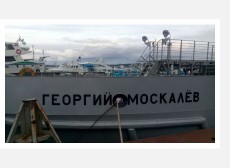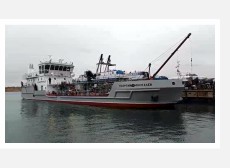 30.10.19 10:41 30.10.19 10:41
RT37 bunkering tanker/ecological vessel "Georgiy Moskalev" departed for running trials
  
On 30.10.2019 the special RT37 bunkering tanker/ecological vessel for Baikal "Georgiy Moskalev" departed for running trials from Irkutsk.
This "tanker-plant" is constructed at Eastern-Siberian River Shipping Company due to the order of FSE "Rechvodput" of RosMorRechFlot for FBE "Administration of Baikal-Angarsk basin of inland waterways". Corresponding contract was signed on 25.12.2017. Keel of the vessel was laid down on 05.04.2018. Vessel was launched on 17.07.2019.
RT37 concept is a self-propelled bunkering tanker/ecological vessel, collector of oily water and sewage as well as dry garbage. Vessel's class notation of Russian River Registry is  M 3,0 (Ice 30) A. RT37 is a double shaft single deck steel vessel with forecastle and poop, with superstructure and ER located aft, with double bottom and double sides in the cargo area and in the area of processing units. M 3,0 (Ice 30) A. RT37 is a double shaft single deck steel vessel with forecastle and poop, with superstructure and ER located aft, with double bottom and double sides in the cargo area and in the area of processing units.
Vessel's overall dimensions (LxBxD) are as follows: 51.60 x 10.23 x 2.60 m. Deadweight for draught 1.8 is about 280 t.
Cargo tanks' capacity is as follows: 82 m³ for DO, 17 m³ for Lub. Oil, 59 m³ for sewage, 25 m³ for oil water, 2.1 m³ for sludge.
Speed of 16.5 km/h was reached during trials when both engines (261 kW each) worked; the contracted speed is 16.0 km/h.
Crew is 7 people (9 places).
Project was developed by Marine Engineering Bureau on the basis of yet constructed vessels, namely RT18 bunker vessels and RT29 ecological vessels. RT37 consolidated indeed ability of these projects, taking in mind that "holy sea" of Baikal requires the highest river class "M" (all the prototypes are of "O" class) while providing enough small draught of 1.8 m.
Working project was developed at Gorkiy Central Project-Design Bureau in Nizhniy Novgorod.
RT37 vessel is called "tanker-plant" because she not only collects wastes but also recycles them, and bunkers the vessels in service.
Decision concerning constructing of ecological vessel / bunker vessel for Baikal were accepted in 2017 as a result of the meeting of the interagency working group on the development of passenger water transport and tourism in the basin of the Baikal Lake. This vessel should be able to supply other vessels by fuel oil and lub oil, and to take oily or solid wastes away from another vessels.
This moment at Baikal basin oily waters and sewage can be pumped to complex proceeding station for vessel wastes "Samotlor" only; this station is operated by PJSC Easter-Siberian River Shipping Company.
Due to information of domestic authorities, more than 7 thousand of small-sized vessels are registered at Baikal basin. About 700-800 t of oily water and sewage are taken onboard "Samotlor" during navigation period; this amount is insufficient to meet norms of ecologic law. By the way, "Samotlor" is placed far away from northern part of the lake, where dumping of oily water and sewage is out of control.
The huge number of vessels don't discharge wastes to special facilities but directly into the lake. According to some investigations, annually 160-400 t of oil products and sewage are discharged into the lake.
The new ecologic vessel shall carry out voyages in the Baikal Lake to the places of the largest vessels' concentration. This will significantly reduce the amount of oil water, sewage and dry garbage polluting the lake.
As the head of Buryatiya Alexei Tsydenov noted, the new eco-bunker vessel will burn garbage and process oily water. She will take onboard both liquid and solid wastes, as well as sewage and oily water from other vessels; discharge clean water.
The vessel is intended for taking from the shore, transporting and discharging to the shore or other vessel oil products (with flash point more than 60°C), diesel oil and lubricating oil (viscosity of up to 50 cSt at t = 50°C). Also there are foreseen collecting, purification and transportation to the place of processing oily water and sewage, as well as dry garbage.
Due to the class notation, RT37 tanker is intended for operation in the waves of 3% probability 3.0 m height.
The vessel's autonomy is as follows: 15 days for fuel and lub. oils store, 15 days for provision, 17 days for drinking water reserve.
Wheel house with big windows and all-round view is located aft.
Double bottom height is 900/1000 mm. Double sides width is 1000/1200 mm.
Areas for dry garbage are foreseen on the main deck; they contain 37 garbage containers of 0.25 m³ each.
Simultaneously cargo loading/unloading operations for following systems are foreseen: diesel/lub. oil cargo system, oily water cargo system and sewage cargo system.
Diesel/lub. oil cargo system provides closed loading by shore pumps and unloading by vessel's submerged pumps. It foresees simultaneously cargo loading/unloading operations for 4 kinds of cargo, namely 2 kinds of diesel oil and 2 kinds of lub. oil. Each tank has its own manifold providing cargo loading/unloading at both sides.
Maximal loading capacity for each diesel oil tank is 50 m³/h; correspondingly when cargo loading is effecting through common manifold, general Maximal loading capacity is 100 m³/h. Maximal loading capacity for each lub. oil tank is 15 m³/h.
Cargo pumps for diesel oil and lub. oil has electrical drive gear equipped by frequency convectors, providing smooth control of the pump revolutions. This allows to produce high-quality tank cleaning due to reduced output.
Oily water cargo system provides closed oily water loading from other vessels, purification and discharging by vessel's submerged pumps. Corresponding tanks are divided into 2 groups: side tanks for purified oily water and CL ones for unprocessed oily water. Each group has own manifold providing loading/unloading at both sides. Oily water separator is foreseen for oily water purification. Purifies oily water is pumping into corresponding tanks. Sludge from the oily water separator is pumped into sludge tanks. Sludge re-pumping to the preparing tank is foreseen for further sludge burning in incinerator. After cargo operation completing, cargo residuals are pushed from cargo line to reception facility by compressed air.
Sewage cargo system provides closed sewage loading from other vessels, processing and discharging by vessel's submerged pumps. There is also vacuum sewage collecting unit for servicing vessel's without own sewage pumps. Corresponding tanks are divided into 2 groups: side tanks for processed sewage and CL ones for unprocessed sewage. Sewage processing unit of physical-chemistry type is foreseen. The degree of purification is sufficient to discharge treated water into the city sewer. Treated sewage is discharged into corresponding tanks. After cargo operation completing, cargo residuals are pushed from cargo line to reception facility outside water. Wastewater cargo tanks are equipped by residuals loosening and flushing equipment.
Keel of the head RT37 vessel "Georgiy Moskalev" was laid down on 05.04.2018 in Irkutsk. Vessel was launched on 17.06.2019.
|



